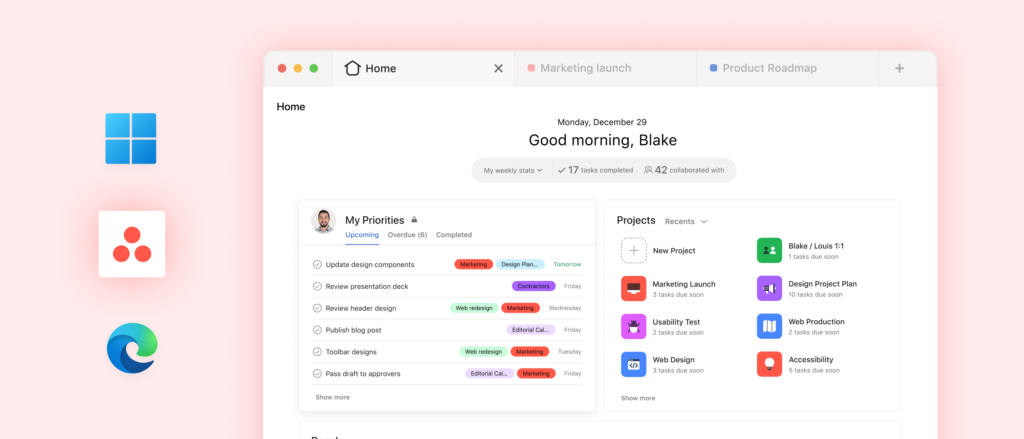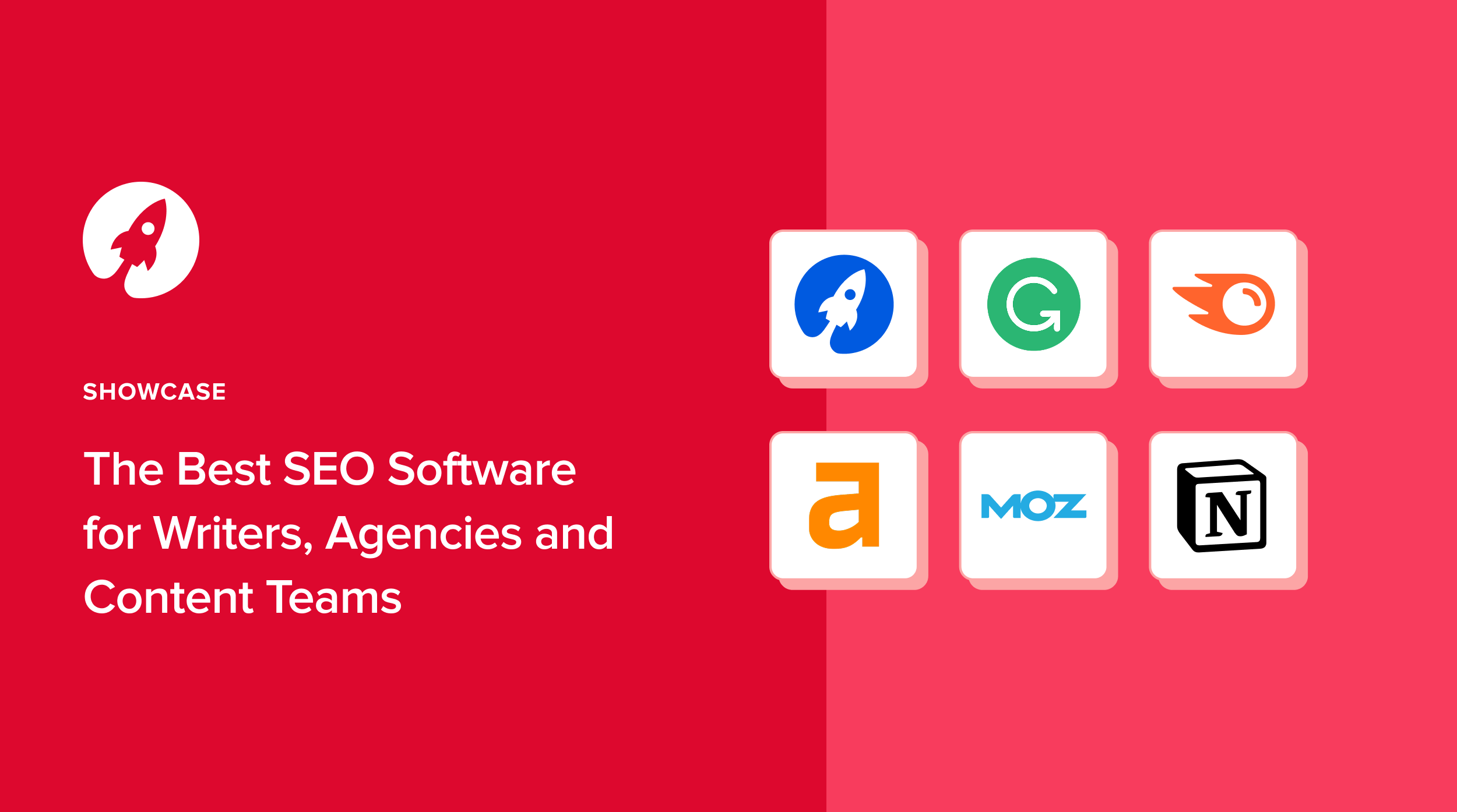When it comes to scaling your content strategy, SEO software is non-negotiable.
Whether you’re a solo writer, managing a creative agency or leading a fast-paced content team, having the right SEO software in your stack makes the difference between guesswork and results.
As someone who’s spent years juggling client deadlines, blog calendars, and SEO performance, I’ve come to rely on a handful of software platforms that actually move the needle.
In this guide, I’m sharing the best SEO software that has helped me (and teams I’ve worked with) write better, rank higher, and report faster.
Let’s start with a definition.
- What Is SEO Software?
- 6 SEO Software for Writers, Agencies, and Content Teams
- FAQs
- Final Word
What Is SEO Software?
SEO software refers to digital tools that help you optimize content, track keyword performance, improve search rankings, and monitor overall site health.
These tools often combine features such as keyword research, content scoring, backlink analysis, and performance tracking, all tailored to enhance visibility in search engines.
Why SEO Software Is Essential for Writers, Agencies, and Content Teams
Let me break down why each group relies on SEO tools differently.
For Writers
SEO software helps writers find the right keywords, structure their content, and get real-time feedback on readability and optimization, without needing to be SEO experts.
For Agencies
Managing multiple clients means juggling dozens of blogs, reports, and rankings.
Good SEO software streamlines this by offering automated workflows, collaborative tools, and white-labeled reports.
For Content Teams
When multiple people are involved, alignment is everything. SEO software helps teams stay on track with shared dashboards, content briefs, optimization suggestions, and clear key performance indicators (KPIs).
6 SEO Software for Writers, Agencies, and Content Teams
Now, let’s look at the 6 best SEO tools you can use if you’re a writer or part of an agency.
1. SEOBoost: The Writer’s SEO Companion
Why it’s best for writers, agencies, and teams: SEOBoost simplifies keyword research, briefs, and optimization into one seamless experience. It’s ideal for content creators who want to focus on writing, not spreadsheets.
If I could only pick one platform to manage content creation from research to ranking, it would be SEOBoost. It’s an all-in-one SEO tool built specifically for content teams and solo creators who want smarter workflows and better results.
Here are its key features and how you can use them:
Topic Reports
I use SEOBoost’s Topic Reports to identify low-competition, high-volume keyword clusters.
These are automatically organized in different categories, such as relevant questions to answer or alternative titles to use for images.
These categories are a game-changer when you’re building out editorial calendars or trying to scale topical authority.
That’s because they eliminate guesswork for keywords, and, instead, provide data-backed content ideas that actually work.
Content Briefs
Instead of spending hours on outlines, I generate SEOBoost Content Briefs. These include headings, link suggestions, target keywords, word count ranges, and competitor benchmarks.
This feature is ideal for teams or freelance writers who require structured content briefs to create content that performs effectively.
Content Optimization
As I write, SEOBoost analyzes my draft in real-time and scores it based on keyword use, structure, and readability.
It even suggests where to add or remove keywords, how to improve formatting, and how to hit ideal word counts, making content optimization super easy, rather than feeling like a chore.
SEO Content Audit
For older blog posts or underperforming pages, I rely on SEOBoost’s audit feature. It highlights content gaps, outdated keywords, and readability issues, then provides a step-by-step guide to refresh and re-optimize them.
The color-coded report is super helpful in identifying what’s missing from the content. This alone can save you a significant amount of time that would otherwise be spent identifying these missing areas.
Content Management
All my content, from content ideas to final drafts, lives inside SEOBoost’s content management dashboard. It helps keep my workflow organized, track what’s published, what’s in draft, and what needs updating next.
What I love the most about this feature is that you can also upload, organize and store all your multimedia content.
This feature is helpful for agencies that have a ton of visual content to store.
Pricing: Starts with a free trial, followed by paid plans starting from $30 per month and going up, depending on usage and team size.
2. Grammarly: The Content Editor’s Best Friend
Why it’s best for writers, agencies, and teams: For agencies and content teams, it enhances quality control and streamlines editing workflows.
You might not immediately think of Grammarly as an SEO tool, but trust me when I say this: content quality matters.
Even the best-optimized blog post won’t rank if it’s unreadable or riddled with errors. Grammarly ensures every piece of content is polished, professional, and aligned with your brand tone.
Here’s how Grammarly supports SEO-driven content:
Grammar and Spelling Checks
This is the obvious one, but it’s essential.
Clean, error-free writing increases credibility, both for search engines and readers. Grammarly catches everything from typos to misused commas in real-time.
Clarity and Readability Enhancements
Grammarly’s clarity suggestions help cut through fluff and keep sentences sharp. I’ve found this particularly helpful when editing long-form content where attention spans drop off.
Tone and Engagement Analysis
This is a hidden gem. Grammarly scores your content on tone of voice, making sure it sounds approachable or professional based on your goals.
For SEO, that’s critical, as your tone heavily impacts how users perceive your brand. For instance, if your copy is targeted more towards Gen-Z or the younger generation, the copy should reflect that to maximize user retention. Similarly, if your product is targeted at professionals with decision-making roles, the copy should be less casual and more solution-focused.
Grammarly’s tone analysis makes sure that you maintain the right tone throughout your content.
Pricing: Free version for basic edits; Premium starts around $12 per month and is well worth it for professional writing teams.
3. Google Analytics: To Track Website and Audience Metrics
Why it’s best for writers, agencies, and teams: Writers can see what posts attract the most traffic, agencies use it to justify ROI to clients, and teams get real data to iterate on what works.
Google Analytics isn’t just for performance marketers. It’s an essential part of any SEO strategy because it shows you exactly how your content is performing and where your traffic is coming from.
Here’s what makes Google Analytics one of the best SEO software tools for writers and content teams:
Monitors Organic Traffic
Organic traffic refers to visitors who land on your website through unpaid search results on search engines. This type of traffic is one of the most significant outcomes of an SEO-driven strategy and, therefore, one of the most valuable forms of traffic, as it tends to be highly targeted, cost-effective, and often reflects strong search intent.
The organic traffic report indicates whether my SEO efforts are practical. I use it to track performance after publishing and spot trends across top-performing blogs.
Track Users’ Behavior and Audience Insights
Bounce rate, session duration, and pages per session are all important Google ranking factors. That’s because they all help measure the quality of content.
I use this data to refine structure, tone, and CTAs, especially in longer guides and landing pages.
More importantly, understanding your users’ locations, devices, and interests can inform your content strategy and help you with topic selection and formatting choices.
Pricing: Completely free to use. Set it up correctly and connect it with your site (ideally also pair it with Google Search Console).
4. Looker Studio: The Data Visualization Tool
Why it’s best for writers, agencies, and teams: Looker Studio helps writers and strategists visualize SEO performance clearly, agencies can automate reports, and content teams can align around dashboards that actually make sense.
Previously known as Google Data Studio, this is the reporting platform that has changed how you present SEO metrics, both to internal stakeholders and clients.
Here’s how Looker Studio helps content teams win:
Custom SEO Dashboards
One of its most outstanding features is that you can build dashboards that pull from Google Analytics, Search Console, and even SEOBoost.
These visualizations make it easy to track keyword rankings, traffic trends, click-through rates (CTRs), and other key metrics in one place.
Client Reporting
You can also use Looker Studio for monthly reports. This feature is especially helpful for agencies that want to deliver compelling SEO reports for client retention.
One of the reasons the reports from Looker Studio are effective is due to their visual elements. Clients usually appreciate visuals over raw spreadsheets as they are easier to understand and track. And by presenting information in a digestible manner, you can save hours by auto-updating based on the connected data sources.
Data Integration
You can pull in data from spreadsheets, BigQuery, YouTube, and tons of other sources, which is ideal if you run content across multiple platforms.
This integration makes it easy to group data in one place, rather than compiling it across different platforms.
Pricing: Free to use, but requires some time investment to build dashboards. Well worth it once your templates are in place.
5. Moz Pro: The Team-Friendly SEO Solution
Why it’s best for writers, agencies, and teams: Writers can uncover content gaps, agencies can track competitors, and teams can coordinate optimization strategies with clarity.
Moz Pro offers a user-friendly dashboard that tracks rankings, site health, and backlink profiles. It is a multi-tool for monitoring and improving domain health, especially when working across client sites.
Here’s how Moz Pro helps content-focused SEO workflows:
Keyword Explorer for Smarter Research
Moz’s Keyword Explorer gives you insights into search volume, difficulty, organic CTR, and priority scores. Unlike some tools that list keywords, Moz helps you prioritize, which is exactly what a content team needs when building an editorial strategy.
For example, if you’re working on a niche B2B article, you can plug in broad and specific terms and use Moz’s filtering tools to find long-tail opportunities you can realistically rank for. This saves time and reduces content churn.
Rank Tracking That’s Actually Actionable
Moz Pro’s Rank Tracker lets you monitor keyword movements over time across specific geographies, devices, or competitors. This is perfect for agencies managing SEO KPIs or writers looking to prove their content’s impact.
You can even tag groups of keywords by campaign or type of content, making performance analysis easier.
Site Crawl and Technical SEO Insights
This is one of my favorite features for content audits. Moz’s Site Crawl gives you a prioritized list of technical issues, including broken links, duplicate content, and missing metadata.
Even if you’re not technical, the explanations are straightforward. Writers can fix what’s in their control (like meta descriptions), and teams can assign the rest to devs.
Backlink Analysis and Link Opportunities
Moz’s Link Explorer helps agencies and teams understand a site’s link profile and identify opportunities to earn more. While not as comprehensive as some other SEO analysis tools, it still provides a clear view of domain authority, linking domains, and spam scores.
This can be useful when running content-driven link-building campaigns. You can use it to spot top-performing posts from competitors and reverse-engineer similar topics.
Pricing: Moz Pro plans start at $49 per month, which includes one user seat and limited keyword tracking. Higher-tier plans expand seat access and tracking limits, making them ideal for agencies and mid-sized content teams.
6. Asana: A Collaboration Tool for Content Teams

Why it’s best for writers, agencies, and teams: Asana keeps everyone aligned. Writers can see briefs and deadlines, agencies can track client deliverables, and content teams can manage production pipelines without dropping the ball.
While not a traditional SEO tool, Asana is my go-to platform for managing SEO content workflows, and it’s a lifesaver when working with writers, editors, designers, and SEO specialists in various locations and time zones.
Caption: An example of a content calendar created in Asana
Here’s how Asana enhances SEO content management:
Editorial Calendar Management
I use Asana’s board and timeline views to build out entire editorial calendars. Each blog post receives its own task, which includes subtasks for writing, SEO checks, graphic design, and publishing.
Color-coded tags make it easy to distinguish between different clients or campaigns.
Content Brief and Asset Sharing
You can also attach SEOBoost-generated content briefs, image assets, and keyword research directly into each task, so writers have everything they need in one place.
This eliminates the need to chase different documentation, as everything can be shared on a single platform. By doing this, you essentially free up more time to focus on SEO research.
This helps keep feedback loops tight and ensures everyone sticks to SEO guidelines.
Seamless Collaboration & Feedback
Comments, @mentions, and task dependencies keep everyone in sync. Editors can drop feedback, designers can upload visuals, and clients (if you invite them) can review timelines.
It also integrates with tools like Slack, Google Drive, and even Loom, making it super adaptable to your workflow.
Pricing: Asana’s free plan is surprisingly robust for small teams. Premium features (like timelines, advanced workflows, and automation) start at $10.99/month per user. For agencies handling multiple brands or complex projects, upgrading is worth it.
FAQs
Which SEO software is best?
The best SEO software depends on your role. For content creators, SEOBoost is unmatched in its ability to handle everything from research to optimization. Agencies often rely on tools like Semrush or Moz Pro for scalability and reporting, while teams value collaboration tools like Asana or Grammarly to streamline content production.
Is SEO free or paid?
SEO can be performed for free using tools like Google Analytics and Search Console. However, for more advanced insights, automation, and competitive analysis, paid SEO software is often essential.
Which software is needed for SEO?
You’ll need tools for keyword research, on-page optimization, performance tracking, technical audits, collaboration, and content management. The exact stack depends on your workflow and whether you’re a solo writer or managing multiple clients.
Final Word
As someone who’s navigated the messy middle of content creation for both solo blogs and agency projects, I can confidently say that your tool set matters.
Use this list as a starting point. Test what fits your needs.
And remember, even the best SEO software is only as good as the strategy behind it.




